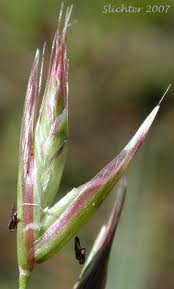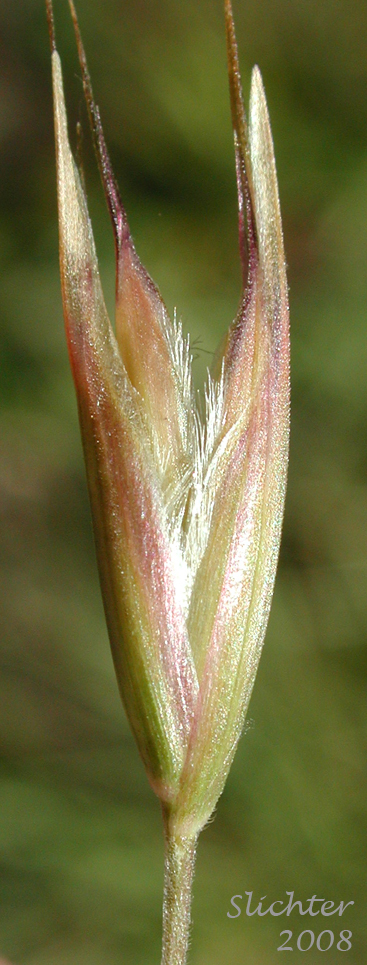Classification
Danthonia
californica
lies within the domain
Eukarya
because it has a
nucleus which differeniates it from being
Prokaryotic. Its
Kingdom is Plantae, this clade includes flowering plants, conifers,
gymnosperms, ferns and more;
California oatgrass
fits into this kingdom because it is a flowering plant. Next, it is
in the Phylum Anthophyta because again, it is a flowering plant and
angiosperms are flower producing plants. (In relation, the
superdivision of this oatgrass is Spermatophyta because it
is seed producing and the division below the superdivision is
flowering plant). The California oatgrass is both seed producing and
a flowering pants which allows us to place it into these taxonomic
levels. Next, Danthonia
californica is in the
Class of Liliopsida
because it is a seed
producing plant that
has an embryo with only
one cotyledon and veins that run parallel in the leaves.
Liliopsida
is thought to be a
synonym for the name
Monocotyledon,
because the root word
"Mono" means one, therefore stating that the species in this class
have one cotyledon. A subclass of the
Monocotyledones
is Commelinidae,
along with three other
subclasses that
California oatgrass does not belong to.
This specie then falls
into the order
Cyperales
which is an
order of
Monocotyledoneous
plants that extends
into the family
Poaceae. Poaceae, also referred to as Gramineae or true grasses,
is a very large family of flowering plants that contains
domesticated and wild species. California Oatgrass then falls into
the Genus of Danthonia which is a large genus consisting of
perennial grasses that tend to have narrow leaves. This
perennial grass family of Poaceae
has six
subfamilies that all contain the characteristics that species
within Poaceae have, one being their erect structures;
these subfamilies include Panicoideae,
Arundinoideae, Chloridoideae, Centothecoideae, Aristidoideae,
and Danthonioideae (Barker et al. 2006). The
genus Danthonia contains many species, close to a
hundred, and Danthonia
californica is one of them. Each of the species in this genus all differentiate
significantly between one another.
Danthonia californica
is known to be in the Aveneae tribe within the series
of Festuciformes. Festuciformes, along with the three
other series Phragmitiformes, Eupanicoidae, and Chloroidoidae
all belong to the family Gramineae (Wet, de J. M. J.,
1954). DNA sequence data was used from
three chloroplast regions and one nuclear region to figure out
the relationships of the genera in the subfamilies.
A subclass of the
Monocotyledones
is Commelinidae,
along with three other
subclasses that
California oatgrass does not belong to.
This specie then falls
into the order
Cyperales
which is an
order of
Monocotyledoneous
plants that extends
into the family
Poaceae. Poaceae, also referred to as Gramineae or true grasses,
is a very large family of flowering plants that contains
domesticated and wild species. California Oatgrass then falls into
the Genus of Danthonia which is a large genus consisting of
perennial grasses that tend to have narrow leaves. This
perennial grass family of Poaceae
has six
subfamilies that all contain the characteristics that species
within Poaceae have, one being their erect structures;
these subfamilies include Panicoideae,
Arundinoideae, Chloridoideae, Centothecoideae, Aristidoideae,
and Danthonioideae (Barker et al. 2006). The
genus Danthonia contains many species, close to a
hundred, and Danthonia
californica is one of them. Each of the species in this genus all differentiate
significantly between one another.
Danthonia californica
is known to be in the Aveneae tribe within the series
of Festuciformes. Festuciformes, along with the three
other series Phragmitiformes, Eupanicoidae, and Chloroidoidae
all belong to the family Gramineae (Wet, de J. M. J.,
1954). DNA sequence data was used from
three chloroplast regions and one nuclear region to figure out
the relationships of the genera in the subfamilies. Nine clades
were retrieved by the data; at the base of the subfamily, three
relationships are understood which have three clades of
Merxmuellera species.
The earliest clade that diverged most likely does not belong to
Danthonioideae,
which as said before is
a subfamily of the
Poaceae.
The other two clades are
around the tropical African mountains and Cape mountains. A
clade from North and South America, as well as New Guinea is
observed (Barker et al. 2006).
Danthonia californica is a specie found in mostly the southern
hemisphere, however this oatgrass moved north into the
western coast of the United States inhabiting Northwestern
California in the North American continent. Arundinoideae is monophyletic,
meaning it descended from a common evolutionary ancestor that is
not shared with any other group.
Nine clades
were retrieved by the data; at the base of the subfamily, three
relationships are understood which have three clades of
Merxmuellera species.
The earliest clade that diverged most likely does not belong to
Danthonioideae,
which as said before is
a subfamily of the
Poaceae.
The other two clades are
around the tropical African mountains and Cape mountains. A
clade from North and South America, as well as New Guinea is
observed (Barker et al. 2006).
Danthonia californica is a specie found in mostly the southern
hemisphere, however this oatgrass moved north into the
western coast of the United States inhabiting Northwestern
California in the North American continent. Arundinoideae is monophyletic,
meaning it descended from a common evolutionary ancestor that is
not shared with any other group.